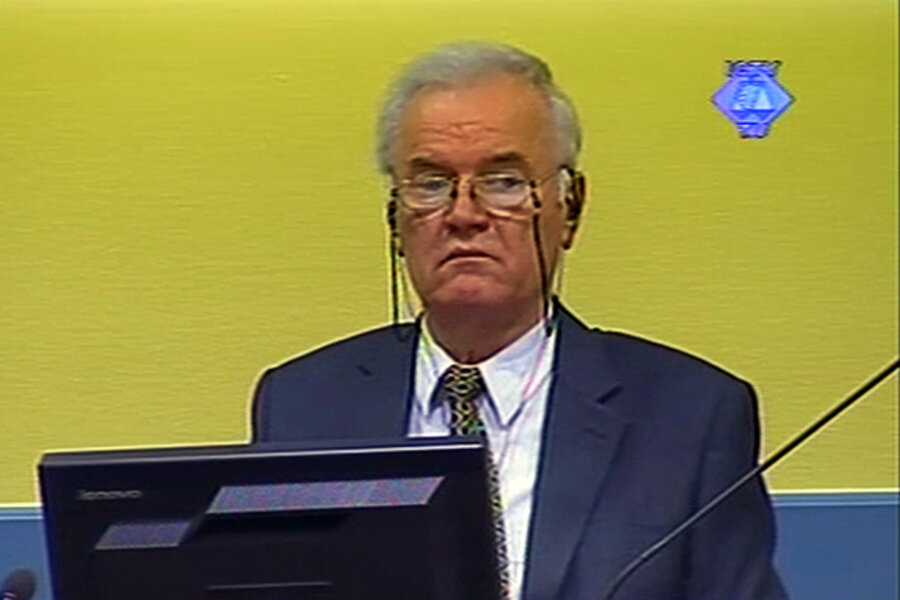Mladic trial: first witness recounts escape from massacre during Bosnian war
Loading...
| Paris
For more than three hours on Monday, the first witness in Bosnian Serb General Ratko Mladic's war crimes trial Elvedin Pasic told a harrowing story of wandering for months through fields and towns of Bosnia at age 13 with his family, before finally being rounded up - then escaping a massacre by Serb soldiers of some 150 Muslim men, including his father.
Mr. Mladic, captured in June, 2011 after 15 years on the run, faces 11 counts of genocide and crimes against humanity in one of the final trials of the Yugoslav tribunal, set up by the UN in 1993 as the first court of its kind. As his trial resumed today, hundreds of Bosnians gathered in the streets of Sarajevo to remember the killing of some 7,000 men in Srebrenica, the worst single act of brutality in Europe since the Nazi period.
The opening of the Mladic trial has gone through a series of embarrassing delays. In both May and June prosecutors failed to turn over parts of key documents, requiring a restart today.
Mr. Pasic, now 34, testified about ethnic cleansing in Bosnia and described life near Grbavica before the war as a time of ethnic harmony. He had many Serb and Croat friends and schoolmates – “we played basketball [and] shared everything … shoes and shorts, we had a great time" – before he was forced to escape his home and go on the run.
In perfect English interrupted by frequent bouts of emotion, he recounted how Serbs from neighboring towns had began to make tank trenches in the woods, frequently invaded Muslim homes to search for weapons, and helped Serb paramilitary shell and torch his town with the aim of carving out a racially pure "Greater Serbia" in the Balkans starting in the summer of 1992.
Mladic prosecutors intend to demonstrate a systematic ethnic cleansing campaign that went beyond a few key individuals and required the willing compliance of many figures in the military, media, politics, and broader society. The tribunal has spearheaded the use of a legal strategy known as "joint criminal enterprise" to prove crimes against humanity.
Two birds with one stone
Radovan Karadzic, the other main surviving actor allegedly responsible for the Srebrenica massacre and president of the Bosnian Serbs during the war, is standing trial alongside Mladic.
With Mladic and Mr. Karadzic both on trial, “You can show the Bosnian Serb political leader and military leader … with different responsibilities,” argues Mark Ellis, director of the London-based International Bar Association.
“Together they act as part of a common plan. This doesn’t take away individual responsibility, or … command responsibility. But it adds to the approach of showing a common purpose and design that underlie large scale atrocities.”
The one-sided war left 2.2 million people displaced, more than 100,000 killed, and involved a brutal siege of the multiethnic city of Sarajevo.
Mladic has steadily denied these charges, even calling them “monstrous” at one point. The man once dubbed the "Butcher of Bosnia" and the architect of the Srebrenica massacre sat erect but impassively as Pasic testified.
Srebrenica is key
“Srebrenica will be the key to this prosecution,” Mr. Ellis added. “It is the event that most seared this conflict into history.”
In their pursuit of a genocide verdict, prosecutors are likely to use Directive No. 7, a document signed by Karadzic directing combat operations to “create an unbearable situation of total insecurity” in which Muslim civilians have “no hope of further survival or life” around the towns of Srebrenica and Zepa.
Mladic’s defense team may also face video footage of the general standing in front of a large crowd of unarmed civilians in the center of Srebrenica, as Serb forces enter and Dutch UN peacekeepers withdraw. He pats the head of a young boy and says, "Don't be afraid. Take it easy. Thirty buses are coming ... to deliver you... No one will hurt you."
But in footage aired on Belgrade TV that was aired later that day, a heavily breathing Mladic states, "... we are giving this town to the Serbian people. The moment has finally come for us after the 19th century rebellion against the Turks, to take our revenge on them..."
Serb forces then tracked down scores of Bosnian men and killed most of them in what the United Nations had declared was one of several "safe havens" to be protected.





